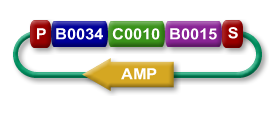Difference between revisions of "Help:Plasmid backbones/Glossary"
| Line 1: | Line 1: | ||
| + | <font size="1">< [[Help:Plasmids]]</font> | ||
| + | |||
__notoc__ __NOEDITSECTION__ | __notoc__ __NOEDITSECTION__ | ||
{|width=700px | {|width=700px | ||
Revision as of 14:37, 25 January 2008
|
Here at the Registry, we use the term "plasmid" in three different ways:
| |
Plasmid backbone | |

|
BioBrick plasmids form the "backbone" of all BioBrick parts. Every BioBrick part is maintained on at least one BioBrick plasmid. Sometimes, a part is maintained on multiple BioBrick plasmid backbones, which vary in antibiotic resistance and replication origin (plasmid copy number). |
| |
Construction plasmid | |
|
If you just want one of the BioBrick plasmids, it is probably available in the iGEM DNA distribution with the part BBa_P1010, BBa_I52001 or BBa_I52002 in the cloning site. You will need the cell strain DB3.1 since each of these three parts constitutively expresses the protein CcdB which is toxic to most strains. | |
|
When making a brand new BioBrick part, you will need to choose an appropriate BioBrick plasmid (with the right antibiotic resistance marker, copy number etc.) for your construction purposes. To make construction and assembly of BioBrick parts easier, most BioBrick plasmids include the ccdB positive selection marker (encoded in BioBrick parts BBa_P1010, BBa_I52001 and BBa_I52002) by default. The ccdB positive selection marker produces a toxic protein which kills most E. coli strains. Successful insertion of a BioBrick part into a BioBrick vector replaces the ccdB gene and enables cells to grow and divide to form colonies. A common problem during BioBrick part construction and assembly is that BioBrick vectors are not 100% digested when cut with restriction enzymes. The ccdB toxic gene ensures that cells transformed with uncut or religated plasmids do not grow. Thus, any colonies you obtain after a BioBrick part construction or assembly are more likely to be correct.
| |
Plasmid with any BioBrick part(s) | |

|
This term refers to a plasmid backbone with one or more BioBrick parts inserted. An example of this can be seen to the left, where BioBrick parts BBa_B0034, BBa_C0010 & BBa_B0015 have been inserted into an ampicillin resistant plasmid. |

